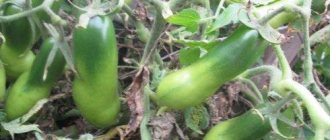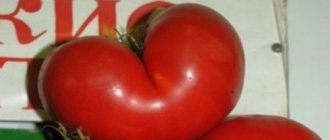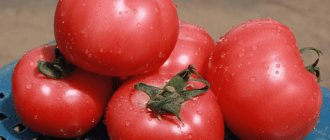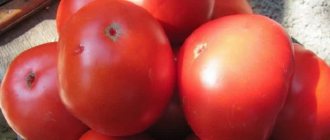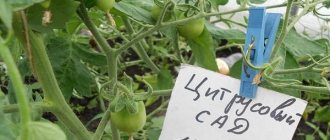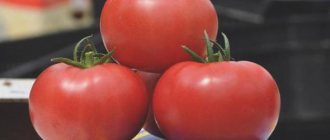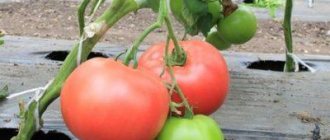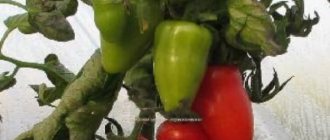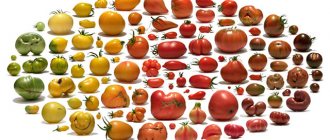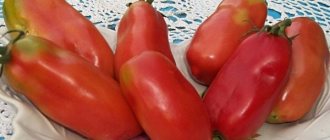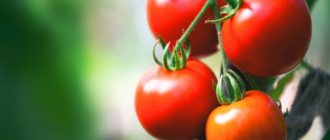Grow masterpieces in the garden - amazingly tasty and beautiful? Breeding masters have created the Mona Lisa tomato, which is easy to cultivate and rich in yields. Farmers no longer have a choice; it is simply impossible to resist the perfect hybrid.
| Height | Landing location | Ripening time | Fruit color | Fruit size | Origin | Fruit shape |
| Medium height | Greenhouse, Open ground | Early ripening | Reds | Large | Hybrid | Flat-round |
Hybrid tomato variety Mona Lisa: features and advantages
The plant belongs to the category of early varieties with a short ripening period.
Even under unfavorable weather conditions, the first fruits appear no later than 90 days after placing the seeds in the ground. Germination and flowering occur together. The yield is even and stable throughout the growing season; the plants wither after the first frost. The manufacturer gives the following description of the variety:
- Mature bushes are tall. In open ground they grow up to 130 cm, in a greenhouse they grow up to 180 cm or more. This often leads to the development of crown rot. The stem and leaves are light green in color. The foliage is sparse and evenly covers the branches.
- The fruits are regular spherical in shape, slightly flattened vertically. The tomatoes are large, bright red in color, weigh up to 300 g. The peel is dense and smooth, glossy. The color is uniform, there is no light spot on the stalk. According to reviews from farmers, the taste characteristics of the fruit are high. The consistency of the pulp resembles a watermelon, there are no fibers. The taste is pronounced tomato, slightly sour.
- The productivity of the variety is high. If you follow the recommendations for sowing and care, it is up to 20 kg per 1 m² in open ground. In greenhouse conditions, the yield is 2 times lower. Uniform ripening of fruits facilitates their collection and processing.
Advantages and disadvantages of the variety
Mona Lisa tomatoes are bred for cultivation in risky farming areas. They tolerate sudden changes in temperature and humidity well. The plants are hardy, resistant to dampness and drought.
Description of the hybrid tomato Peterhof and characteristics of the fruits Read
The variety has the following advantages:
- High yield. This property makes it possible to grow fruits on an industrial scale even in a small private farm.
- Good keeping quality. Large fruits have a strong skin that does not burst during transportation and storage in bulk in boxes. If the proper conditions are created (humidity, light, temperature), tomatoes can be stored for up to 3 months after harvest.
- Resistance to infectious diseases. Plants are immune to verticillium blight, blight and cladosporiosis.
- The versatility of the fruit. They are eaten raw, in the form of slices, salads and juices. Ketchup, adjika and other types of preparations are made from tomatoes. Whole tomatoes are not rolled because they are too large.
A definite disadvantage is the size of the tomatoes: they do not fit into standard jars and create a lot of pressure on the stems. Because of this, the bushes need garter. With heavy fruiting, several supports may be needed.
During the ripening period, plants need increased feeding. With its deficiency, fruit formation stops.
The tomato also reacts negatively to the abundance of nitrogen (which occurs in greenhouses), and growth occurs in the green mass in the absence of fruits.
Description of potato variety
This variety includes the following types of potatoes:
- “Mona Lisa” is a mid-early variety; up to 2 kg can be harvested from one bush. Tubers are elongated oval, yellowish flesh;
- "Asterix" is a later variety that produces a stable yield, above average. It is distinguished by a reddish skin, yellow pulp with high taste;
- “Yarla” is an early variety, unpretentious to conditions, has large, round, yellow tubers;
- "Ukama" is a variety with a fast ripening period. Its tubers are oval, large with yellowish flesh. Scratches received during assembly do not spoil its appearance;
- “Cleopatra” is an early ripening variety with a reddish skin and superficial eyes. The potatoes are large and oval. Can be grown on clay or sandy soils;
- "Latona" - oblong large tubers that can be harvested 75 days after planting;
- “Friesia” is a medium-ripe variety with cream-colored flesh. It can be stored for a long time without sprouts, but does not like lack of moisture and poor soil.
IMPORTANT: There are other varieties of potatoes that produce high yields - “Red Scarlett”, “Impala”
Advantages and disadvantages
Those types of potatoes that are commonly called “Dutch” have the following advantages:
- High yield;
- Tubers ripen early;
- Leveled socket;
- Good presentation with small eyes;
- Resistance to viral diseases.
These are mainly table varieties.
FOR REFERENCE: In Europe, “Dutch” is grown on an industrial scale for the preparation of semi-finished products.
Peculiarities
Such potatoes will have the following characteristics:
- Not susceptible to certain diseases.
- The ability to grow certain varieties in drought conditions, with less daylight, and at higher temperatures.
- Attractive appearance with small eyes.
Features of the variety
The plant belongs to the category of early varieties with a short ripening period. Even under unfavorable weather conditions, the first fruits appear no later than 90 days after placing the seeds in the ground. Germination and flowering occur together. The yield is even and stable throughout the growing season; the plants wither after the first frost.
The manufacturer gives the following description of the variety:
- Mature bushes are tall. In open ground they grow up to 130 cm, in a greenhouse they grow up to 180 cm or more. This often leads to the development of crown rot. The stem and leaves are light green in color. The foliage is sparse and evenly covers the branches.
- The fruits are regular spherical in shape, slightly flattened vertically. The tomatoes are large, bright red in color, weigh up to 300 g. The peel is dense and smooth, glossy. The color is uniform, there is no light spot on the stalk. According to reviews from farmers, the taste characteristics of the fruit are high. The consistency of the pulp resembles a watermelon, there are no fibers. The taste is pronounced tomato, slightly sour.
- The productivity of the variety is high. If you follow the recommendations for sowing and care, it is up to 20 kg per 1 m² in open ground. In greenhouse conditions, the yield is 2 times lower. Uniform ripening of fruits facilitates their collection and processing.
Landing rules
Queen Elizabeth's strawberry mustache requires careful handling. To plant bushes, you need to follow the following algorithm:
- Dig holes following the recommended pattern.
- Pour a little soil into each and add fertilizer.
- Moisten the soil generously.
- Place the plants in the prepared recesses, carefully straightening the roots.
- Fill the holes and cover the bushes with plastic bottles with holes.
- As soon as the soil dries out a little, moisten it again.
Fertilizing must be done before flowering begins. It is better if it is an ash solution or specialized preparations.
Manufacturer's summary
Breeders present a hybrid for open ground and temporary shelters. Can be grown in unheated greenhouses. But the plant becomes stretched, and the tomatoes are affected by blossom end rot.
Technical data:
- early ripening hybrid (from germination to first fruits - 95 days);
- semi-determinate (height 1.8 m);
- fruit yield is stable, high (20 kg/m²);
- medium foliage;
- The color of the stems and plates is light green.
Mona Lisa tomatoes are resistant to TMV, verticillium blight, blight, and cladosporiosis. Competent agricultural technology makes it possible to grow significant fruit yields in the southern regions and in the risky farming zone. The hybrid is recommended for individual gardens.
Tomato Mona Lisa description of variety photo reviews
Every summer resident dreams of getting early produce from their own beds. Tomato Mona Lisa F1 is an ideal find for lovers of delicious berries. With the right agricultural technology, already at the end of June the table will be decorated with fragrant fruits.
Manufacturer's summary
Breeders present a hybrid for open ground and temporary shelters. Can be grown in unheated greenhouses. But the plant becomes stretched, and the tomatoes are affected by blossom end rot.
- early ripening hybrid (from germination to first fruits - 95 days);
- semi-determinate (height 1.8 m);
- fruit yield is stable, high (20 kg/m²);
- medium foliage;
- The color of the stems and plates is light green.
Mona Lisa tomatoes are resistant to TMV, verticillium blight, blight, and cladosporiosis. Competent agricultural technology makes it possible to grow significant fruit yields in the southern regions and in the risky farming zone. The hybrid is recommended for individual gardens.
What fruits
Breeders give the following description of the fruit:
- color – red;
- shape – round, slightly flattened;
- there is no spot on the stalk;
- the skin is dense, not rough;
- high resistance to cracking;
- the pulp is juicy, the consistency resembles a watermelon;
- the taste is bright, with sourness;
- “tomato” aroma, strong;
- weight – up to 300 g.
The authors of the hybrid recommend consuming the fruits fresh. They are delicious sliced, salads, and juices. Gardeners have made their own additions: they prepare pastes, lecho, and can the whole thing.
There are varieties similar to the Mona Lisa: Leningrad Chill, Wind Rose. They have related characteristics: early ripening, taste, resistance to diseases. The transportability of the Wind Rose is somewhat lower.
How to grow
An early ripening hybrid has its own characteristics. It needs complete mineral supplements. Insufficient application provokes a delay in berry ripening. Sensitive to excess nitrogen: the bush fattens (actively increases green mass), fruits do not set.
Simple rules for growing a decent harvest:
- sowing seedlings in mid-March;
- after germination, maintain the temperature at 18 ⁰C;
- illuminate with an agricultural lamp;
- be sure to feed with mineral complexes for tomato seedlings;
- picking into individual containers when 2 true leaves grow;
- mandatory hardening and ventilation;
- planting in a permanent place after the last spring frosts;
- formation into 2 stems;
- obligatory garter;
- placement of bushes: 40 cm x 50 cm (8 plants/m²);
- mulching the soil with rotted sawdust;
- obligatory garter of stems and brushes;
- systematic pinching and lightening;
- application of mineral fertilizers according to instructions on the packaging;
- moderate watering in the morning (water should not fall on the stem or leaves);
- constant removal of weeds;
- timely harvesting of fruits.
Before the onset of cold nights (mid-August in the middle zone), tomatoes should be removed for ripening indoors. Knowing the characteristics of the plant and following the rules of cultivation will allow you to obtain high yields of tasty berries.
Gardeners' opinions
Gardeners give positive feedback. They like high yields. The hybrid sets fruit even in cool weather. Gradual ripening allows canned food to be prepared evenly. Decent taste is combined with good transportability.
Gardeners include strong foliage as a disadvantage. Height > 1 m makes it difficult to create temporary shelters. Not everyone wants to bother with tying up bushes.
The hybrid Mona Lisa has taken a strong position in personal plots. Delicious fruits delight owners from mid-summer until autumn.
Hybrid tomato Mona Lisa is a variety that produces tasty and early fruits. The plant was bred by domestic breeders and is intended specifically for cultivation in open ground. Shelters are provided only as a temporary measure during periods of maturation or prolonged bad weather. User reviews indicate that the Mona Lisa f1 tomato bears fruit well even in northern latitudes, where the weather is cool almost all summer.
Features of the variety
The plant belongs to the category of early varieties with a short ripening period. Even under unfavorable weather conditions, the first fruits appear no later than 90 days after placing the seeds in the ground. Germination and flowering occur together. The yield is even and stable throughout the growing season; the plants wither after the first frost.
The manufacturer gives the following description of the variety:
- Mature bushes are tall. In open ground they grow up to 130 cm, in a greenhouse they grow up to 180 cm or more. This often leads to the development of crown rot. The stem and leaves are light green in color. The foliage is sparse and evenly covers the branches.
- The fruits are regular spherical in shape, slightly flattened vertically. The tomatoes are large, bright red in color, weigh up to 300 g. The peel is dense and smooth, glossy. The color is uniform, there is no light spot on the stalk. According to reviews from farmers, the taste characteristics of the fruit are high. The consistency of the pulp resembles a watermelon, there are no fibers. The taste is pronounced tomato, slightly sour.
- The productivity of the variety is high. If you follow the recommendations for sowing and care, it is up to 20 kg per 1 m² in open ground. In greenhouse conditions, the yield is 2 times lower. Uniform ripening of fruits facilitates their collection and processing.
Advantages and disadvantages of the variety
Mona Lisa tomatoes are bred for cultivation in risky farming areas. They tolerate sudden changes in temperature and humidity well. The plants are hardy, resistant to dampness and drought.
The variety has the following advantages:
- High yield. This property makes it possible to grow fruits on an industrial scale even in a small private farm.
- Good keeping quality. Large fruits have a strong skin that does not burst during transportation and storage in bulk in boxes. If the proper conditions are created (humidity, light, temperature), tomatoes can be stored for up to 3 months after harvest.
- Resistance to infectious diseases. Plants are immune to verticillium blight, blight and cladosporiosis.
- The versatility of the fruit. They are eaten raw, in the form of slices, salads and juices. Ketchup, adjika and other types of preparations are made from tomatoes. Whole tomatoes are not rolled because they are too large.
A definite disadvantage is the size of the tomatoes: they do not fit into standard jars and create a lot of pressure on the stems. Because of this, the bushes need garter. With heavy fruiting, several supports may be needed.
During the ripening period, plants need increased feeding. With its deficiency, fruit formation stops.
The tomato also reacts negatively to the abundance of nitrogen (which occurs in greenhouses), and growth occurs in the green mass in the absence of fruits.
Growing technique
Growing the Mona Lisa variety is no different from cultivating other tomatoes, but in relation to this species, there are some nuances.
It is necessary to pay attention to the following points:
The taste of this tomato can be enjoyed by gardeners in both warm and cool areas. The main difference between Mona Lisa and other nightshades is the ability to actively bear fruit in open beds. You can learn more about cultivation and ways to increase yield in the plant description.
Description of the variety
Every year, breeders introduce gardeners to tomato varieties that do not require warm summers and dense greenhouses. However, to grow the Mona Lisa, it is enough to provide temporary shelter, after which the already strong bushes readily develop in an open area of the garden.
Attention! When buying seeds, be careful: you can find a hybrid of the same name on sale. Its characteristics will vary.
16 excellent varieties of plums for the Moscow region
- the bushes are compact, street specimens rarely grow above 130 cm, in shelter they can reach 180 cm;
- stepsoning is necessary;
- leading into 2-3 stems;
- foliage is medium, leaves are light in color;
- the ovary is abundant, 5-6 tomatoes each;
- cut tomatoes without fibers, the consistency is closer to watermelon.
Attention! It is advisable to use the harvest fresh or use it for sauces and soups. The fruits are not suitable for preservation.
According to ripening time
By type of growth
By type of use
By growing method
Fruit weight (g)
Productivity (kg/m2)
Fetal characteristics
Advantages and disadvantages, as agronomists say
The main advantage of the tomato is its adaptability. Mona Lisa adapts to temperature changes and does not reduce productivity during the cold summers typical of northern regions. In addition to frost resistance, agronomists highlight the following advantages:
- The productivity is so high that tomatoes can even be grown in industrial quantities for sale.
- Storage can last up to 3 months, which is also beneficial for farming and more.
- Resistance to infections such as cladosporiosis and verticillium, very rare manifestations of rot.
- Fruit quality. The pulp is slightly fibrous and juicy.
- Requirement for fertilizers.
- Ovarian support is required.
- Impossibility of whole-fruit canning.
- The ovary is so abundant that 70 tomatoes have already been counted from 5 bushes. They ripen together, the stalk has an even red color. The taste is bright, the sourness is noticeable, but there is more sweetness (Vera, Tomsk).
- The tomato lasts until frost and bears fruit constantly. Late blight is not susceptible, mostly due to its early ripening. It is necessary to fertilize correctly; inconsistency leads to oppression of the ovary (Nikolai, Voronezh region).
- For preservation, you will have to plant a different variety; this tomato is more suitable for salads and ketchup. It will be difficult for a beginner to grow (Anna, Kurgan).
Features of agricultural technology
At first glance, caring for tomatoes is not difficult: you can plant them outside greenhouses, most diseases are not scary. However, some stages of cultivation require attention.
Flower bed design. TOP 10 simple and effective techniques
- By the end of March, the seeds should already be prepared and sown.
- Seedlings require long-term lighting; it is recommended to use a lamp and choose the sunny side.
- Feeding with mineral compounds.
- It is better to mulch with rotted sawdust.
- Tomatoes can be planted densely, but not more than 8 per m2.
- The garter is necessary immediately, because... the fruits are heavy for the stems.
- You need to form 2 stems, but many gardeners leave 1 more. This helps to increase the yield.
- You should not leave more shoots, otherwise the fruits will be sparse and will not reach the expected size.
It is better to water in the morning, making sure that the water gets only under the roots. If there is a risk of early frost, unripe tomatoes are collected and left to ripen in boxes. The tomato captivates with its bright taste and persistent character. Recommended for juices and salads.
Mona Lisa: video
Description of the tomato variety Lisa, characteristics and yield
Today, there are several thousand different varieties and hybrids that have individual distinctive characteristics in cultivation, bush shape and fruit quality. The Lisa tomato is one of the medium-sized crops. Despite its similarity with other hybrids, this vegetable crop has a number of advantages and is very popular among novice gardeners and experienced vegetable growers.
Characteristics and description of the variety
The Lisa variety tomato belongs to the ultra-early standard hybrids. From the first sprouting of seedlings to the mass harvest, 85-90 days pass. The variety has proven itself well in small farm and large-scale production. Recommended growing areas: open and closed ground.
Main characteristics and description of the variety:
- The plant is a determinate species, 90-100 cm high.
- The bush is compact, medium leafy.
- The leaves are medium sized, dark green in color.
- The inflorescences are simple, loose, collected from 6 to 12 large flowers.
- Pedicel with articulation.
- The number of nests on one shoot is 4-5.
Productivity in open ground is up to 10 kg. from 1 sq. m., in greenhouse conditions up to 17 kg. from 1 sq. m.
Recommended growing areas: Russia, Moldova, Ukraine.
Description of fruits
The peculiarities of the variety are that it is endowed with a friendly inflorescence and fruit set. In addition, all his tomatoes are of the same structure and the same size, which is quite valuable in industrial production.
General description of the fruit:
- shape – cuboid;
- average weight – 110-120 g;
- skin – smooth, medium-dense;
- color – orange-red;
- pulp – tender, four-chambered;
- taste – good consumer quality.
Tomato Elizaveta is intended for fresh consumption and processing. Higher quality fruits are observed in their own juice.
Advantages and disadvantages of the variety
Hybrid Lisa, like all fruit crops, has its pros and cons.
The advantages of culture include the following indicators:
- high productivity;
- long fruiting;
- large fruit;
- disease resistance;
- ease of care;
- resistance to temperature changes.
In addition, the variety has high taste and technological qualities.
The vegetable crop has no major disadvantages. The only disadvantage of this variety is that it requires careful transportation over long distances.
It is worth paying attention: if you make an effort, Lisa can grow and bear fruit well at home
Features of cultivation
Despite the fact that the Lisa tomato variety is an unpretentious plant, agricultural technology affects its tomato quality.
Let's consider the basic care requirements:
- To prevent the bush from cracking during growth, it is recommended to form it into 2 stems.
- The plant requires regular watering, but it does not tolerate swampy soil.
- As expert reviews have shown, the crop is responsive to potash and phosphate fertilizers.
- To avoid breaking the bushes due to the weight of the fruit, it is recommended to tie it to a support.
- To prevent the plant from growing, pinching and removal of excess foliage and shoots is required.
The recommended planting scheme is 4 bushes per 1 sq. m.
By following these simple agricultural practices, the Lisa variety will delight every gardener with a high yield of beautiful tomatoes. And thanks to their universal purpose, everyone can get dishes of high taste from them, be it a light salad or winter canning.
The best varieties of tomatoes for 2021: photos and descriptions
When choosing tomatoes for their plot, gardeners, first of all, rely on varietal or hybrid characteristics. Productivity is the most important criterion on which the quantity and quality of the harvest depends. Sometimes it can be difficult to choose the right option from the rich variety of tomatoes for open ground and greenhouses. Then varieties are selected depending on the growing region, ripening period, degree of disease resistance and other factors.
A huge number of species with excellent yields are intended for growing vegetables in the open air. Low-growing bushes with large fruits are one of the advantages of tomatoes for the soil. Such heat-loving plants are easier to care for and do not require complex agricultural practices.
According to ripening period
Tomatoes, like other vegetable crops, are characterized by different ripening periods, from early to late.
| Ripening period | Ripening of fruits after the appearance of the first shoots | general characteristics | The most productive tomatoes (2020) |
| Ultra-early ripening | On day 80-85 | The fruits are small, juicy, and low in sugar. The height of the bush is no more than 50 cm. Not suitable for preservation. | Little Red Riding Hood, Pride of Russia, Benito, Superstar, Valentina, Marisha, Maksimka |
| Early ripening | For 90-95 days | Small, delicate fruits, average yield. Suitable for canning and salads. Bushes grow up to 70 cm | Agatha, Riddle, Augustine, Lyana, Sanka, Buyan, Lakomka, Amur standard, Grandmother's kiss |
| Mid-early | On days 100-103 | The fruits are juicy, small, aromatic. The purpose is universal. Bush shape - compact | Openwork, Babushkino, Pulka, Red Giant, Russian Soul, Cardinal, Flamingo |
| Mid-season | On day 100-115 | High taste, excellent yield. There are both low-growing and tall varieties | Scarlet Candles, Hybrid Basket, Stresa, Intuition, Black Baron, Pudovik, Pink Honey |
| Late ripening | On day 120-130 | Excellent fruit taste, high yield, universal purpose. Good keeping quality and transportability of fruits | Giraffe, Cosmonaut Volkov, Titan, Rio Grande, Russian size, King of Kings, Rocket, Premier |
The ripening time, color and shape of tomatoes depends on the variety.
Usually early-ripening vegetables with not large fruits and not a large harvest, but with a quick, friendly yield of ripe tomatoes. Mid-season ones also have medium sizes. Late ones are usually difficult to care for, but it is among them that you can find champions in weight, but there are not many such beauties on the bush.
Every year, breeders create new species with high quality indicators. In stores you can buy specialized varieties of tomatoes designed for growing in certain climatic conditions. Classification by regions of Russia:
- for the Moscow region: Champion, Sweet Bunch, Honey, Pink Elephant, Fireworks, Bull's forehead;
- for the southern regions: Torch, Novice, Titan, Winner, Bison, Ermak, Gift, Mikado;
- for the middle zone: Bull's Heart, Black Prince, Uzbek (Yusupov), Moskvichka, Snowdrop, Big Brother, Spasskaya Tower;
- for Siberia: Siberian heavyweight, Ultra early ripening, Sanka, Abakan pink;
- for the Urals: Coin, Bull's Heart, Button, Countryman, Yellow Buyan, Bullfinch, Demidov;
- for the far north: Snowy Tale, Ballerina, Ladyfingers, Berdsky Large, Countryman, Oak, Gina.
An unpredictable, cold or, conversely, excessively warm climate is not a reason to refuse to grow tomatoes in open ground. Thanks to selection, varieties have been developed that grow and develop well in any terrain.
To obtain a rich harvest, you need to choose tomato varieties not only with the appropriate characteristics. It is necessary that this criterion be supplemented by such an indicator as disease resistance.
READ MORE: Rhododendron Roseum Elegans
Late blight, root rot, tobacco mosaic, cladosporiosis are diseases that most often affect plantings of heat-loving crops.
A catalog of tomatoes that can withstand the onslaught of various diseases:
- Blitz;
- Koenigsberg;
- Geisha;
- Betta,
- Anyuta;
- Bohemia;
- Chio-chio-san;
- Tatiana;
- Puzata hut;
- Lights of Moscow;
- Yablonka Russia;
- Crimson giant.
Unfortunately, there are no varieties that are 100% resistant to infections. But there are hybrids that produce a harvest until the active phase of many fungal diseases and infections begins.
Having a good greenhouse at your disposal, you can get fresh tomatoes to your table all year round. Greenhouse varieties are suitable for preparing salads or canning. Excellent salad tomatoes can be obtained from the following varieties:
- Geisha;
- Fairy gift;
- Andromeda;
- Eagle beak;
- Pink Angel;
- Pink Pearl;
- Fatalist;
- Scarlet caravel;
- Amana orange
The best varieties for preservation:
- Auria;
- Banana legs;
- Pink raisins;
- Rajah;
- Baba;
- Alexander the Great.
Cherries are sweet, small tomatoes that grow well both outdoors and in a greenhouse, but small-fruited vegetables tend to be more productive in protected beds. Magic Harp F1 and Yellow Caramel F1 are hybrids whose fruit weight does not exceed 25 g.
When choosing a vegetable for a greenhouse, many rightly give preference to tall and high-yielding varieties. But low-growing plants, which usually have an early ripening period, as well as mid-ripening tomatoes, are also excellent for polycarbonate shelters in all regions of Russia.
For open ground, breeders also offer species with high yields of hybrid origin; they are resistant to diseases and temperature changes. The best tomato varieties of 2020:
- Intuition F1 is one of the best tomato hybrids for picking with trusses, mid-season, from germination to harvesting the first vegetables - 110 days.
- Katya F1 is an early ripening hybrid. The fruits weigh 90-130 g and ripen simultaneously. From 1 m² you can harvest more than 10 kg of fruit per season.
- Search F1 – unpretentious and at the same time tasty tomatoes. The hybrid withstands cold weather and is immune to most diseases. The bushes are strewn with small red fruits, which are excellent for pickling and canning.
- Blagovest F1 is an early-ripening hybrid. The fruits are round, glossy, with slightly pronounced ribbing. From one bush you can collect up to 5 kg of fruit.
- La la fa F1 - has excellent consumer qualities, high yield and unpretentiousness. The average weight of the fruit is 140-170 g. From 1 m² you can harvest up to 20 kg.
- Vladimir F1 - has a high yield and is suitable for cultivation in any type of soil. High productivity throughout the entire fruiting period.
- Beef King F1 is an early maturing Dutch hybrid. The tomatoes are round, dense, smooth. From one bush you can collect up to 4-5 kg. Resistant to low temperatures and diseases.
- Ashdod F1 – tomatoes with smooth, dense skin. Fruit weight is from 110 to 140 g. The pulp has a bright burgundy color.
- Tanya F1 is a hybrid from the Netherlands with excellent immunity, dense structure, and good yield. The fruits have a regular round shape, weighing 150-200 g. They tolerate transportation well.
If the designation on a bag of planting material is F1 – hybrids of tomatoes (or other plants) of the first generation, F2 – of the second, and so on.
Exceptional taste, fruit weight, constant yield, disease resistance, adaptation to weather conditions are the advantages of hybrids over tomato varieties.
Reviews
My favorite tomato variety in 2021 is Idol, medium-sized, very tasty, productive. I planted seedlings on March 20, the first fruit was picked on June 20. The bushes bear fruit for 3 months. The most successful cherry variety is Black Cherry, very tasty and productive, the most favorite tomato of children.
I like the fruits to be large and regular in shape. Therefore, I prefer the varieties Early Rose, Peach, Heavyweight of Siberia and Pink Fig. This year I raised Grandma's Secret. The bush is determinate, the average height is 180 cm. I have never produced kilogram fruits, the maximum weight is 700-800 g. Probably this is because I allow the bush to form into two or three stems.
I never conduct systematic analysis. I analyze when the tomatoes are already picked. I love large, sugary berries. I really like the Pink Giant in taste, but the yield is low. So far, my requirements are relatively met by 2 varieties - Pink Andromeda and Mazarin. Over time (I’m a novice gardener) I’m thinking of finding the optimal variety or hybrid of tomatoes.
READ MORE: Tomato lapwing characteristics and description of the variety yield reviews photos
Now I mainly grow tomatoes in my dacha. About 20 different varieties. Red, yellow, brown, black. Beauty! Cherry, Cream, Ox heart. Different sizes, different tastes, different ripening periods - from May to October. The main thing is that the weather is warm. I’m not keen on canning, so we use fresh vegetables. If the harvest is good, I give the remaining tomatoes to relatives.
Stability of the harvest from year to year, the ability to adapt to weather conditions, resistance to pests and diseases are important criteria for a reliable tomato variety. In 2021, you can plant both time-tested tomatoes and new elite varieties. The choice depends only on the preferences of gardeners.
Tomato Lisa - description and characteristics of the variety
Tomatoes are one of the common and most frequently grown vegetable crops. Today, many new varieties have been created that differ in taste, fruit shape, care characteristics, ripening speed, and so on. Among the mid-season species, the Lisa variety has proven itself well. He has a lot in common with other hybrids like him. It also has its own differences and features, which are, in fact, advantages. Many vegetable growers have chosen this variety.
Characteristics
The Lisa variety belongs to the standard, artificially bred tomato varieties. It belongs to the tomato species of the middle ripening period, since at least 3 months pass from the appearance of the first shoots to the final ripening of the fruit.
Over the entire period of its existence, “Liza” tomatoes have received recognition from owners of small farms and large agricultural enterprises. The culture grows well and develops in any conditions: greenhouses, greenhouse conditions, as well as in open areas.
Tomatoes of this variety belong to the determinant type. The bush grows up to 1 meter in height. At the same time, it turns out to be compact, the amount of leaf cover is average. The leaves themselves are dark green and small in size.
The inflorescences of the variety are quite simple: each has from 6 to 12 flowers. They are all large and voluminous. The number of nests on each individual shoot is from 4 to 5.
As for yield, it is worth knowing that in a greenhouse you can get the number of ripe fruits twice as high as the number of tomatoes growing in open soil. Thus, in greenhouse conditions the yield reaches 17 kg, and in an open area - only 10 kg per square meter of land. If the crop is grown for sale, it is much more profitable to organize greenhouses.
The most successful territories for growing the variety are Ukraine, Moldova and Russia.
Fruit
The fruits have an interesting, unusual cube shape. The size of one fruit is average, reaching 120 grams. The peel is smooth to the touch and of medium density, which allows the tomatoes to maintain their shape and appearance during transportation. Resistant to external mechanical influences.
Red-orange tomatoes have four chambers inside that contain seeds. The taste meets consumer requirements. The pulp is very tender and juicy. The “Liza” variety is suitable for fresh consumption and for use in processed form, for example, in winter preparations and snacks. The best option, in which tomatoes express their taste to the maximum, is freshly squeezed tomato juice.
Advantages of the “Liza” variety
The variety has a lot of advantages, which are enough to make a choice in its favor. The main advantages include:
- High yields, which makes the variety suitable for growing for sale not only for small farms, but also for large industrial enterprises.
- Long fruiting period.
- The fruits are large in size.
- Resistant to external damage.
- Good protective properties of the variety against pests and diseases characteristic of vegetable crops.
- Easy to care for and grow.
- Resistance to adverse climatic conditions.
Among other things, tomatoes hold their shape well and are able to maintain an attractive presentation for a long time.
Nuances in care
The “Lisa” variety is responsive to proper care. Primary requirements:
Formation of a plant in the amount of a pair of stems
This will prevent the possibility of cracking. Regular, moderate watering, it is important to avoid waterlogging of the soil. Fertilizer application - many years of practice have shown that this variety especially loves nitrogen and phosphorus fertilizing. It is imperative to tie the bushes to a support to keep the stem intact. The fruits of the variety are quite heavy. Therefore, this is the first thing you should pay attention to.
The variety belongs to the determinant type, so it is necessary to carry out pinching and remove excess foliage and branches.
Taking into account all the features of care that do not require much time and effort, you can get a high-quality harvest. It is suitable for both sale and home use.
Advantages and disadvantages of the variety
Mona Lisa tomatoes are bred for cultivation in risky farming areas. They tolerate sudden changes in temperature and humidity well. The plants are hardy, resistant to dampness and drought.
The variety has the following advantages:
- High yield. This property makes it possible to grow fruits on an industrial scale even in a small private farm.
- Good keeping quality. Large fruits have a strong skin that does not burst during transportation and storage in bulk in boxes. If the proper conditions are created (humidity, light, temperature), tomatoes can be stored for up to 3 months after harvest.
- Resistance to infectious diseases. Plants are immune to verticillium blight, blight and cladosporiosis.
- The versatility of the fruit. They are eaten raw, in the form of slices, salads and juices. Ketchup, adjika and other types of preparations are made from tomatoes. Whole tomatoes are not rolled because they are too large.
See also
Characteristics of the Gift tomato variety, planting and care
Read
A definite disadvantage is the size of the tomatoes: they do not fit into standard jars and create a lot of pressure on the stems. Because of this, the bushes need garter. With heavy fruiting, several supports may be needed.
During the ripening period, plants need increased feeding. With its deficiency, fruit formation stops.
The tomato also reacts negatively to the abundance of nitrogen (which occurs in greenhouses), and growth occurs in the green mass in the absence of fruits.
Monalisa
General characteristics: mid-early, table, Dutch potato variety with elongated oval tubers. Preferable for growing in gardens and household plots, as well as in small farms. Resistant to mechanical damage.
Ripening period (vegetation): 65-80 days.
Weight of commercial tubers (grams): 74-154.
Number of tubers in a bush: 8-12 pieces.
Productivity (c/ha): 201-374 (maximum – 556).
Consumer qualities: good taste, suitable for processing into crispy potatoes, culinary type C, excellent for baking and boiling.
Keeping quality (storage ability): 93%.
Peel color: yellow.
Flesh color: light yellow.
Preferred growing regions (RF): Central.
Disease resistance: the variety is resistant to potato blight and is affected by golden cyst nematode. Susceptible to late blight on tops, resistant to late blight of tubers.
Features of cultivation: seed requires special storage conditions - temperature not lower than +4 ° C. Standard agricultural technology. The bushes do not tolerate frost well.
Tomato Mona Lisa - description and characteristics of the variety
The dream of every summer resident is to collect a large amount of harvest from his garden as early as possible. The Mona Lisa variety is a true find for those who love tasty and aromatic tomatoes. If you follow the growing recommendations, already in the last days of June you can enjoy tomatoes grown on your own plot.
Characteristics of the variety
Breeders have created this hybrid variety, which can be grown in open beds or under film covers. It is also possible to grow in unheated greenhouses, however, the bushes become elongated and the tomatoes are damaged by blossom end rot.
- A hybrid variety of early ripeness (the period from germination to harvest is 95 days).
- The plant is semi-determinate, reaches a height of up to 130 centimeters, and in greenhouse conditions can grow up to 180 centimeters and higher.
- It gives a consistently high yield - up to 20 kilograms of ripe tomatoes can be harvested from one square meter.
- The number of leaves is average.
- The color of the stems and blades is pale green.
The plant is highly resistant to most diseases characteristic of tomatoes - cladosporiosis, verticillium blight, tobacco mosaic virus, blight. If you follow the rules for growing, you can harvest a rich harvest of tomatoes in the southern regions, as well as in areas of risky farming. The hybrid variety is intended for individual garden plots.
Description of the harvest
Breeders describe Mona Lisa tomatoes as follows:
- color red;
- round shape, slightly flattened;
- absence of spots near the stalk;
- the skin is not rough, dense;
- the fruits do not crack;
- the pulp is juicy and has a consistency similar to watermelon;
- pronounced “tomato smell”;
- the taste is pronounced, with sourness;
- The weight of each fruit reaches about 300 grams.
The hybrid variety is intended mainly for fresh consumption. The fruits have excellent taste, so vegetable salads and tomato juices are most often prepared from them. But some housewives successfully use such tomatoes to prepare pastes, sauces, lecho, and preserves.
There are types of tomatoes that are similar to this - Leningrad Chill, as well as Wind Rose. The varieties have similar qualities - early ripening, taste, disease resistance. However, the fruits of the Rose of the Winds are slightly less transportable.
Features of cultivation
The hybrid variety of early ripeness has its own characteristics. It must be fed regularly using mineral fertilizers. If you do not fertilize often enough, the fruits will ripen with a delay. In addition, the Mona Lisa variety is sensitive to too much nitrogen in the soil - the plant grows (an active growth of green mass occurs), but tomatoes do not form.
To reap a rich harvest, you need to follow these simple recommendations:
- Seeds are sown for seedlings in the second ten days of March.
- After the seeds germinate, you need to ensure that the air temperature is about 18 degrees.
- It is recommended to use an agricultural lamp for illumination.
- Tomato seedlings must be fertilized with mineral fertilizers.
- When two true leaves appear, the bushes are transplanted into separate containers.
- It is imperative to harden and ventilate the seedlings.
- Tomato bushes should be moved to a permanent location after the spring frosts have subsided.
- The bushes are formed into two stems.
- The plant must be tied up.
- Seedlings are placed according to a 40x50 cm pattern (no more than eight bushes should be located per square meter).
- The soil is mulched with rotted sawdust.
- Be sure to tie up the brushes and stems.
- From time to time the bushes need to be pruned.
Before cool nights set in (in the central regions this occurs in mid-August), it is necessary to remove the tomatoes from the bushes and leave them to ripen indoors.
Gardeners' opinion
Owners of garden plots leave positive reviews about this variety. It is valued for its large yield. Fruit set occurs even under unfavorable weather conditions. Tomatoes ripen gradually, so you can prepare preserves evenly. Excellent taste is combined with good transportability.
Tomato Mona Lisa: characteristics and description of a hybrid variety with photos
Every summer resident dreams of getting early produce from their own beds. Tomato Mona Lisa F1 is an ideal find for lovers of delicious berries. With the right agricultural technology, already at the end of June the table will be decorated with fragrant fruits.
Manufacturer's summary
Breeders present a hybrid for open ground and temporary shelters. Can be grown in unheated greenhouses. But the plant becomes stretched, and the tomatoes are affected by blossom end rot.
- early ripening hybrid (from germination to first fruits - 95 days);
- semi-determinate (height 1.8 m);
- fruit yield is stable, high (20 kg/m²);
- medium foliage;
- The color of the stems and plates is light green.
Mona Lisa tomatoes are resistant to TMV, verticillium blight, blight, and cladosporiosis. Competent agricultural technology makes it possible to grow significant fruit yields in the southern regions and in the risky farming zone. The hybrid is recommended for individual gardens.
What fruits
Breeders give the following description of the fruit:
- color – red;
- shape – round, slightly flattened;
- there is no spot on the stalk;
- the skin is dense, not rough;
- high resistance to cracking;
- the pulp is juicy, the consistency resembles a watermelon;
- the taste is bright, with sourness;
- “tomato” aroma, strong;
- weight – up to 300 g.
The authors of the hybrid recommend consuming the fruits fresh. They are delicious sliced, salads, and juices. Gardeners have made their own additions: they prepare pastes, lecho, and can the whole thing.
There are varieties similar to the Mona Lisa: Leningrad Chill, Wind Rose. They have related characteristics: early ripening, taste, resistance to diseases. The transportability of the Wind Rose is somewhat lower.
How to grow
An early ripening hybrid has its own characteristics. It needs complete mineral supplements. Insufficient application provokes a delay in berry ripening. Sensitive to excess nitrogen: the bush fattens (actively increases green mass), fruits do not set.
Simple rules for growing a decent harvest:
- sowing seedlings in mid-March;
- after germination, maintain the temperature at 18 ⁰C;
- illuminate with an agricultural lamp;
- be sure to feed with mineral complexes for tomato seedlings;
- picking into individual containers when 2 true leaves grow;
- mandatory hardening and ventilation;
- planting in a permanent place after the last spring frosts;
- formation into 2 stems;
- obligatory garter;
- placement of bushes: 40 cm x 50 cm (8 plants/m²);
- mulching the soil with rotted sawdust;
- obligatory garter of stems and brushes;
- systematic pinching and lightening;
- application of mineral fertilizers according to instructions on the packaging;
- moderate watering in the morning (water should not fall on the stem or leaves);
- constant removal of weeds;
- timely harvesting of fruits.
Before the onset of cold nights (mid-August in the middle zone), tomatoes should be removed for ripening indoors. Knowing the characteristics of the plant and following the rules of cultivation will allow you to obtain high yields of tasty berries.
Gardeners' opinions
Gardeners give positive feedback. They like high yields. The hybrid sets fruit even in cool weather. Gradual ripening allows canned food to be prepared evenly. Decent taste is combined with good transportability.
Gardeners include strong foliage as a disadvantage. Height > 1 m makes it difficult to create temporary shelters. Not everyone wants to bother with tying up bushes.
The hybrid Mona Lisa has taken a strong position in personal plots. Delicious fruits delight owners from mid-summer until autumn.
Variety reference
Breeders have created this hybrid variety, which can be fed in open beds or under film covers. It is also possible to grow in unheated greenhouses, but in this case the bushes become elongated and the tomatoes succumb to blossom end rot.
- Hybrid variety of early ripeness (time from germination to harvest is 95 days).
- The seedlings are semi-determinate, reach a height of up to 130 centimeters, in greenhouse conditions they can reach up to 180 centimeters and higher.
- It gives a consistently high yield - up to 20 kilograms of ripe tomatoes can be harvested from one square meter.
- The number of leaves is average.
- The coloring of the stems and plates is pale green.
A real masterpiece from the world of tomatoes - the Mona Lisa F1 tomato: description of the variety and its characteristics
Grow masterpieces in the garden - amazingly tasty and beautiful? Breeding masters have created the Mona Lisa tomato, which is easy to cultivate and rich in yields. Farmers no longer have a choice; it is simply impossible to resist the perfect hybrid.
| Height | Landing location | Ripening time | Fruit color | Fruit size | Origin | Fruit shape |
| Medium height | Greenhouse, Open ground | Early ripening | Reds | Large | Hybrid | Flat-round |
Description and characteristics of the variety
Tomato Mona Lisa F1 is a semi-determinant medium-sized hybrid. The plant is characterized by the following features:
- height of bushes is 1.2-1.3 m in open beds, in a greenhouse 1.5-1.7 m;
- moderate foliage and bushiness;
- light green color of shoots and leaves.
What fruits does a tomato have?
- average weight 250-300 g;
- fleshy watermelon pulp;
- the skin is strong but tender;
- absence of spots on the stalk.
Advantages and disadvantages
- stable yield;
- wonderful taste;
- endurance to cold and heat;
- drought resistance;
- transportability;
- keeping quality;
- immunity to such diseases - TMV, blight, cladosporiosis.
Minuses:
- the need for garter, feeding.
Productivity
The hybrid is characterized by high productivity - 20 kg per 1 m2.
Features of cultivation and storage
The age of bushes for planting is 50-60 days. The beds are pre-fertilized, applied per 1 m2.
- 25 g superphosphate;
- 1 glass of ash;
- 1 bucket of compost.
How to care for maximum yields:
- water 8-10 liters once every 4-5 days;
- saltpeter and phosphorus-potassium mixtures are used for fertilizing;
- mulch with a layer of straw, hay;
- lead bushes into 2-3 shoots;
- stepchildren, leaving stepsons within 2-3 cm.
Advantages and disadvantages, as agronomists say
The main advantage of the tomato is its adaptability. Mona Lisa adapts to temperature changes and does not reduce productivity during the cold summers typical of northern regions. In addition to frost resistance, agronomists highlight the following advantages:
- The productivity is so high that tomatoes can even be grown in industrial quantities for sale.
- Storage can last up to 3 months, which is also beneficial for farming and more.
- Resistance to infections such as cladosporiosis and verticillium, very rare manifestations of rot.
- Fruit quality. The pulp is slightly fibrous and juicy.
- Requirement for fertilizers.
- Ovarian support is required.
- Impossibility of whole-fruit canning.
- The ovary is so abundant that 70 tomatoes have already been counted from 5 bushes. They ripen together, the stalk has an even red color. The taste is bright, the sourness is noticeable, but there is more sweetness (Vera, Tomsk).
- The tomato lasts until frost and bears fruit constantly. Late blight is not susceptible, mostly due to its early ripening. It is necessary to fertilize correctly; inconsistency leads to oppression of the ovary (Nikolai, Voronezh region).
- For preservation, you will have to plant a different variety; this tomato is more suitable for salads and ketchup. It will be difficult for a beginner to grow (Anna, Kurgan).
Correct fit
Another distinctive feature of the “Dutch” will be ease of care. If you correctly follow basic agrotechnical recommendations, you can enjoy a high harvest.
The table presents data on starch content in different varieties:
| Name | Variety | % |
| Nikulinsky | Late ripening | From 12 to 21 |
| Cardinal | Late ripening | 15 |
| Rocco | Late ripening | 16 |
| Ivan da Marya | Late ripening | From 8 to 14 |
| Asterix | Late ripening | 17 |
| Borovichok | Early ripening | From 13 to 17 |
| Elmundo | Early ripening | From 11 to 14 |
| Felox | Early ripening | 16-17 |
| Bellarosa | Early ripening | 12 to 16 |
| Natasha | Early ripening | From 12 to 14 |
| Forty days | Extra early | From 11 to 15 |
| Karatop | Extra early | From 10.5 to 15 |
| Riviera | Extra early | 19,6 |
| Zhukovsky early | Extra early | From 10 to 12 |
| Farmer | Extra early | 12 |
| Crane | Mid-late | 14-19 |
| Sorcerer | Mid-late | From 12 to 15 |
| Mozart | Mid-late | No more than 20 |
| Grenada | Mid-late | From 10 to 17 |
| Melody | Mid-late | From 11 to 17 |
| Yanka | Mid-early | 14,8-15,4 |
| Giant | Mid-early | 16-19 |
| Tuscany | Mid-early | From 12 to 14 |
| Purple Haze | Mid-early | 14,4-17,2 |
| Openwork | Mid-early | From 14 to 16 |
Follow the basic instructions:
- A hole for the sprouted tuber is dug up to 12 cm deep;
- Watered with a mixture of humus and ash;
- Planting materials are placed there with the sprouted side;
- Buried with earth.
The distance between rows is 40–50 cm.
Description of cherry tomato
The Elizabeth hybrid was introduced to the agricultural farming community in 2017. The same year, the tomato was certified by the State Register and approved for growing private household plots in open ground and under film covers in all regions of the Russian Federation.
The plant is indeterminate (2 m or more), the leaves are long, not spreading. The inflorescences are intermediate, the first one is formed above the 8th leaf. The internodes are short, and the knotting rate is very high - a new brush is formed every 12-15 cm. Each cluster contains 20 or more neat ovoid tomatoes (see photo). The weight of one cherry does not exceed 30 g, and more often 18-20 g. The unripe fruits are green in color with a dark spot; when ripe, the tomatoes take on a juicy red tint. The harvest from the lower tiers of bushes can be harvested after 90-95 days from the full opening of the cotyledons.
When cut, the tomato is bright crimson, fleshy, two-chambered, with very few seeds. The taste is dominated by sugar content.
According to ripening time | By type of growth | By type of use | By growing method | Fruit weight (g) | Productivity (kg/m2) | Fetal characteristics |
| Early ripe, 90-95 days | Indeterminate, 200-260 cm | Universal | For film greenhouses and open ground | 20-30 | Greenhouse: 15-18 kg Open ground: 12-14 kg | Red color. Ovoid, cylindrical shape. 2 sockets |
Tomato Monti F1 - description and characteristics of the variety
The Monty F1 tomato appeared recently, but still managed to gain fans. The current variety has gained particular popularity due to the elongated shape of the fruit, as it is especially valued among summer residents.
The hybrid is characterized by the following features:
- The fruits ripen on average in 120 days, and this is the period from the appearance of the first shoots to the first ripe berry.
- Grazing has good resistance to arid climates, so the period of flowering and fruit set can occur even with insufficient moisture.
- The bushes have a compact shape.
- Breeders have calculated the average yield, and the sign exceeds 12 kg per square meter.
- The variety is large-leaved.
- Fruits on all plants ripen almost at the same time.
- Consider separating ripe tomatoes from the main bush.
- Tomatoes tolerate transportation well.
- The illiterate deteriorate over a long period of time.
- The fruits can ripen outside the bush, but only in a dark place with a suitable air temperature.
Ripe tomatoes themselves do not fall off the bush and the stems are not susceptible to rotting. They can be delivered to places of sale and not have to worry about losing their presentation.
The hybrid is best grown outdoors. Moreover, this variety is capable of bearing fruit even in an unheated greenhouse, which should be covered with film
In this case, it is important to reduce the amount of watering
Features of the fruit
The berries of the hybrid are characterized by:
- rich red color;
- in a crowd of about 100 grams;
- ovoid shape;
- slight ribbing at the border between the fruit and the stem;
- the stalk is devoid of a green spot;
- the presence of several chambers for seeds;
- high density skin;
- sweet and sour taste and pronounced aroma;
- significant concentration of dry matter.
As tomatoes reach ripeness, they become denser, so they can be used for marinade and pickles. Some people prefer to use this type for preparing canapés.
Proper care
If we talk about the rules of cultivation, this hybrid is no different from others.
It is best to plant seedlings no earlier than March 15-20. It is recommended to heat the first shoots using a special lamp, and about 18 hours should be allocated for this procedure. To obtain good seedlings, add a fair amount of mineral complexes to the soil. It is important not to forget about hardening and ventilating the room where the seedlings are located. Seedlings need to be provided with a moderate amount of moisture. Beri garden plots can only be planted in May, but the top of the plant must be covered with film. After replanting the hybrid, there is no point in forgetting about mulching the soil. When purchasing a mineral fertilizer, it is important to use it strictly according to the instructions provided directly by the manufacturer. During the process of seedling growth, it is recommended to stop cuttings and also tie up the stems. After the fruits ripen, you need to pick them from the bush.
To obtain high yields from plants grown in a greenhouse, you must remember to regularly ventilate them. Thanks to drip irrigation, it is possible to optimize the consumption of liquid, so the possibility of it getting on the leaves is almost completely eliminated.
Usually, when the first harvest ripens, only large-sized fruits are observed, and later their dimensions begin to decrease.
All pomona fruits should be removed from plants grown in open ground before cold dew appears. As a rule, this phenomenon is observed in August.
Even if the tomatoes are not ripe, they should be placed in a warm place where the sun’s rays do not reach them. This will help bring the fruits to full ripening.
Gardeners' opinions
In (avoidance Monty is characterized by high resistance to pathogens of such diseases, do for how many:
- gray spotting;
- Alternaria blight;
- verticillium.
If long-term transportation of tomatoes is required, then it is best to give preference to berries with thicker skins. After harvesting, the entire harvest retains its original quality over a long period of time. Some gardeners manage to enjoy this variety even with the onset of cold autumn weather.
The hybrid was included in the list of the State Register of Vegetables of Russia. For this reason, it is recommended to grow this crop in a private garden and personal plot.
Gardeners have now noted that the tomato matches the description. In addition, the plant produces a fair harvest. Ripe fruits can be a decoration for prefabricated canned vegetables, as they retain their pleasant taste.
Fruit characteristics
Breeders give the following description of the fruit:
- color – red;
- shape – round, slightly flattened;
- there is no spot on the stalk;
- the skin is dense, not rough;
- high resistance to cracking;
- the pulp is juicy, the consistency resembles a watermelon;
- the taste is bright, with sourness;
- “tomato” aroma, strong;
- weight – up to 300 g.
The authors of the hybrid recommend consuming the fruits fresh. They are delicious sliced, salads, and juices. Gardeners have made their own additions: they prepare pastes, lecho, and can the whole thing.
There are varieties similar to the Mona Lisa: Leningrad Chill, Wind Rose. They have related characteristics: early ripening, taste, resistance to diseases. The transportability of the Wind Rose is somewhat lower.
Description of the tomato variety Mona Lisa and its characteristics
Every summer resident dreams of getting early produce from their own beds. Tomato Mona Lisa F1 is an ideal find for lovers of delicious berries. With the right agricultural technology, already at the end of June the table will be decorated with fragrant fruits.
Manufacturer's summary
Breeders present a hybrid for open ground and temporary shelters. Can be grown in unheated greenhouses. But the plant becomes stretched, and the tomatoes are affected by blossom end rot.
- early ripening hybrid (from germination to first fruits - 95 days);
- semi-determinate (height 1.8 m);
- fruit yield is stable, high (20 kg/m²);
- medium foliage;
- The color of the stems and plates is light green.
Mona Lisa tomatoes are resistant to TMV, verticillium blight, blight, and cladosporiosis. Competent agricultural technology makes it possible to grow significant fruit yields in the southern regions and in the risky farming zone. The hybrid is recommended for individual gardens.
What fruits
Breeders give the following description of the fruit:
- color – red;
- shape – round, slightly flattened;
- there is no spot on the stalk;
- the skin is dense, not rough;
- high resistance to cracking;
- the pulp is juicy, the consistency resembles a watermelon;
- the taste is bright, with sourness;
- “tomato” aroma, strong;
- weight – up to 300 g.
The authors of the hybrid recommend consuming the fruits fresh. They are delicious sliced, salads, and juices. Gardeners have made their own additions: they prepare pastes, lecho, and can the whole thing.
There are varieties similar to the Mona Lisa: Leningrad Chill, Wind Rose. They have related characteristics: early ripening, taste, resistance to diseases. The transportability of the Wind Rose is somewhat lower.
How to grow
An early ripening hybrid has its own characteristics. It needs complete mineral supplements. Insufficient application provokes a delay in berry ripening. Sensitive to excess nitrogen: the bush fattens (actively increases green mass), fruits do not set.
Simple rules for growing a decent harvest:
- sowing seedlings in mid-March;
- after germination, maintain the temperature at 18 ⁰C;
- illuminate with an agricultural lamp;
- be sure to feed with mineral complexes for tomato seedlings;
- picking into individual containers when 2 true leaves grow;
- mandatory hardening and ventilation;
- planting in a permanent place after the last spring frosts;
- formation into 2 stems;
- obligatory garter;
- placement of bushes: 40 cm x 50 cm (8 plants/m²);
- mulching the soil with rotted sawdust;
- obligatory garter of stems and brushes;
- systematic pinching and lightening;
- application of mineral fertilizers according to instructions on the packaging;
- moderate watering in the morning (water should not fall on the stem or leaves);
- constant removal of weeds;
- timely harvesting of fruits.
Before the onset of cold nights (mid-August in the middle zone), tomatoes should be removed for ripening indoors. Knowing the characteristics of the plant and following the rules of cultivation will allow you to obtain high yields of tasty berries.
Gardeners' opinions
Gardeners give positive feedback. They like high yields. The hybrid sets fruit even in cool weather. Gradual ripening allows canned food to be prepared evenly. Decent taste is combined with good transportability.
Gardeners include strong foliage as a disadvantage. Height > 1 m makes it difficult to create temporary shelters. Not everyone wants to bother with tying up bushes.
The hybrid Mona Lisa has taken a strong position in personal plots. Delicious fruits delight owners from mid-summer until autumn.
